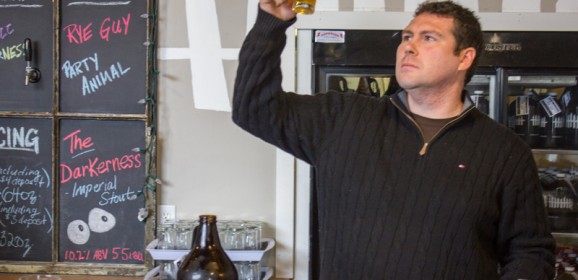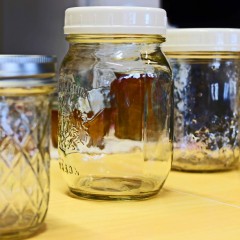Ottawa shelters already at capacity as cold sets in
By Clayton Andres and Thomas Hall As the winter weather worsens, Ottawa’s homeless try to find a place to escape from the cold. But many local shelters are facing difficulties of their own. “We’re at capacity and there’s not a whole lot more room,” said Shirley Roy, manager of community relations at Ottawa Mission. The shelter has more than 230 beds available during the year, but already filled them six weeks ago. Every night, the staff put out mats on the floor to accommodate the overflow of people seeking a place to stay. According to Roy, one of the contributing factors to this overflow is “chronic homelessness,” where people cycle in and out of shelters and many of them end up staying at the same place for several years. ‘I really want to drive home how vulnerable these kids are. If we’re not here to provide these spaces, other people will jump in.’ –Jason Pino Greg Morley has been staying at different shelters around town since July. He is currently spending his nights at the Shepherds of Good Hope in the Byward Market but was previously at the Ottawa Mission on Waller Street. Morley said at both places he saw “pretty much the same” group of people staying over every night. “Generally speaking, once they got a bunk, they’re pretty much there.” Roy said the Ottawa Mission rarely turns away people seeking shelter, but the number of people staying long term has become more of a concern for the staff. Between 40 to 50 of the Mission’s current residents have been staying there for more than two years, Roy said. “It’s an emergency shelter, it’s supposed to be for people in crisis,” he said. “But we don’t want to turn anyone away, especially during the winter.” Homeless adults aren’t the only ones worried about the number of full shelters. Jason Pino is the director of Restoring Hope Youth Shelter, which is aimed towards teens and young adults who can’t find any other place to stay. “There’s two other youth shelters running at 100 per cent capacity all the time,” Pino said. Most of the young adults Pino encounters, he said, were turned away from other youth shelters because there’s no room or because they were too old. Young adults over 19 years old are usually sent to shelters like the Ottawa Mission, despite the lack of beds. The youth shelter is only able to run once a week providing six beds for anyone who comes by looking for a place to stay. Pino said since the shelter set aside a room for girls, he hasn’t had to turn anyone...
Winter bite prompts seasonal depression
By Sarah Trick and Allison McNeely Photo by Shannon Lough The snow, cold temperatures and dark skies of winter cause many people to feel a little down, but for some it can trigger a serious mood disorder. It’s more than the winter blues. Professionals call it seasonal affective disorder. Delaney Dunlop, 23, has had winter depression every year since she was a child, “It’s hard because I lead a very busy lifestyle. I’m constantly going places and doing things, but as soon as the fall hits, I don’t want to go anywhere or do anything.” The main symptom of any kind of depression is a loss of energy, according to Marie Clemont, a counsellor with Catholic Family Service Ottawa. In the case of winter depression, Clemont said medication can be useful, but should be used as a last resort. ‘I definitely think the medical establishment needs to take it more seriously.’ –Delaney Dunlop A treatment that helps many is light therapy, which consists of sitting in front of a special kind of lamp for 20-30 minutes per day. But not everyone has this option. Dunlop said she is unable to use light therapy because of a sensitivity to light. But she noticed this fall that spending a little more time outside has helped. She is currently studying criminology in the MA program at the University of Ottawa after doing her undergraduate degree at Carleton, where underground tunnels connect the buildings. Dunlop said she notices her grades usually drop in the fall, but at the University of Ottawa she is now forced to spend some time outside going to classes, unlike at Carleton. Dunlop said she feels doctors brushed off her condition at first. “I definitely think the medical establishment needs to take it more seriously,” Dunlop said. “Doctors don’t seem to want to deal with it.” Krista Shackleford, 31, has also suffered from the disease for several years. She says the most effective coping strategy is to deal with the symptoms before they become too severe. “I think being aware of your body is important,” Shackleford said. “I find if I ignore the symptoms too long, I get stuck in this vicious circle where I don’t want to exercise or do anything at all to make it better.” She said the best way to be supportive of someone with the disorder is to be encouraging but not forceful. “Try to get them to get out and do things, but don’t drag them out of their comfort zone too much,” she said. “For example, instead of having them go out of their way you could go watch a movie at their...
Winter activities in the works for popular Centretown Park
By Brett Throop and Kyle Duggan A Dundonald Park working group is urging people to come out and play in the park during the winter months. The park, a century-old Centretown landmark on Somerset Street at Bay Street, is a hub for community activities in the summer and one of the most trodden parks in the city. But when the mercury plummets, the visitors dwindle, a 2012 report by a Toronto-based urban consulting firm found. The report researched use of the park and how to improve it. Among other things, it found the park sees about six times fewer visitors in winter. “We are really encouraging people to keep using their community park,” said Christina Marchant, director of Community Health Promotion at Centretown Community Health Centre. The centre works closely with the Dundonald Park working group, which is in charge of getting more visitors to the park based on recommendations from the report. The working group is looking at activities such as cross-country ski and show-shoe lessons, Chinese New Year celebrations and a winter carnival. The carnival could include a snowman making competition, roasted-chestnut vendors and a park-lighting celebration. During summer, the park’s calendar is filled with daily tai chi classes, children’s music programs, line and folk dancing and movie nights. But there is only one listing for November and December on the park’s online calendar of events: a free weekly community meal held by Food Not Bombs. “When it gets to be winter we all want to cocoon a bit more and then our physical activity levels can go down,” Marchant said. “That’s not very healthy for us.” Marchant said that social isolation is greater in winter when people spend more time indoors, and that isolation is a year-round issue for many in Centretown who face language and income barriers. “Getting people out into the park in the winter is a way to break some of that isolation, maybe make some friends and basically support people’s mental health,” she said. Since new activities aren’t expected on the calendar this year, Marchant said the focus is currently on getting people to make their own fun. A group of Algonquin College students is working with the health centre to develop posters to encourage people to enjoy classic winter activities like making snowmen and snow angels in the park. “Once you’re moving and running around and having fun, you don’t feel the cold anymore,” said Mary O’Reilly, one of the students who designed the posters. “We don’t get enough sunlight, so having access to sunlight at all is very beneficial for your mood and getting out and being with...
Canned foods preserve homemade gift tradition
By Diana Matthews, Mara Selanders and Jordanna Tennebaum For those who practice canning fruits and vegetables, it’s about preserving a bygone era as much as it is about preserving food. Emerie Brine, an executive chef with Bernardin, a Canadian home-canning company, drew from memories of his mother when he led a workshop at the Canada Agriculture and Food Museum in Ottawa on Sunday. Brine shared how to make spiced Christmas jelly and cranberry preserves. “I was raised in the age where in the case of food, nothing ever goes to waste,” Brine said as he stirred a mixture of peppers and sugar on the stovetop for the pepper jelly. “If we didn’t have it, we would grow it, and if we grew it, we would pick it.” Brine held the workshop to give holiday gift ideas that would fill stomachs and excite taste buds. At the workshop, spiced cranberry preserves warmed the room with the scent of cloves and cinnamon. “People will think, ‘Wow, you’ve gone through all that trouble just for me?’ ” Brine said. When he first took the jars out of the hot water bath, all of the fruits were crowded at the top of the jar. As Brine demonstrated how to flip the golden jelly jars, light streamed through, showing off suspended red and green peppers. Soon the jars lined the counter. For Brine, supporting local farmers is also a big draw to canning. “If you have the opportunity to grow your own products and you have the opportunity to can them, it’s economics for me,” he said. Terri O’Neill runs canning workshops through Just Food, a non-profit group in Ottawa that promotes sustainable food, and the community gardening network of Ottawa. In a phone interview, she highlighted the deep satisfaction she gets from canning locally sourced food. “I can because I want to support my local economy, my local farmers,” O’Neill said. “Nothing, to me, is better than opening a jar that I’d canned in the summer in February and then that smell of just summer comes out of the jar. It tastes like you picked what’s inside.” O’Neill said that she did not learn how to can from her mother and sought out the practice instead by attending workshops. She said that seeing others go through the steps is essential to learning how to do it. “Eventually my repertoire just kept growing into stuff that I enjoyed to can. As I got more skilled at one thing I would add another item as an experiment and then I would add another one,” O’Neill said. “I really do just enjoy the process. I...






